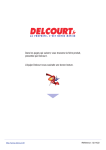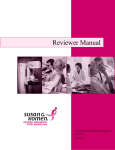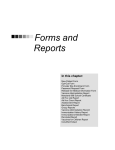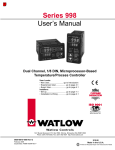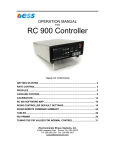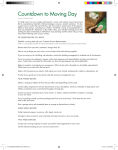Download Webinar Presentation - Center for Technology and Aging
Transcript
Return on Investment for Remote Patient Monitoring – Call for Participants in a California HealthCare Foundation National Study September 12, 2013 Webinar Logistics Welcome and thank you for joining CTA’s ROI for RPM Webinar If you have technical difficulties call 1-866-229-3239 for assistance The Audio for this event will stream through your computer. You can also dial-in to the conference line to hear the audio and verbally ask questions. 1-877-668-4490 (Call-in toll-free number (US/Canada)) Access code: 961 986 094# If you are having audio difficulties, please send a chat message to Valerie Steinmetz or email at [email protected] The Recording and Slides will be available at www.techandaging.org 2 Questions – Two ways to ask questions Ask Questions via the Q&A Box Please submit questions via the Q&A Feature. Please send your questions to All Panelists Verbally ask Questions Dial in to the teleconference: 1‐877‐ 668‐4490 (Call‐in toll‐free number (US/Canada)) Access code: 961 986 094# 3 Presenters David Lindeman, PhD Director, Center for Technology and Aging Co‐Director Health Care, CITRIS, University of California Kamal Jethwani, MD, MPH Corporate Manager ‐ Research and Innovation Center for Connected Health, Partners HealthCare 4 Project Background Joint initiative of Center for Connected Health and Center for Technology and Aging Web‐based, flexible ROI tool created for self‐administration by health care organizations. www.telemedroi.com ROI model first tested with five organizations, who had very different implementation models Goals for the Webinar: Introduce the web‐based ROI Tool and National ROI Study Demonstrate the ROI tool with RPM Program Data Highlight Key Drivers for Positive ROI and Optimizing RPM Programs Answer Questions on Tool Use and How to Participate in the Study 5 Participate in a National ROI Study: Beta Testing the ROI Tool CCH and CTA are conducting the first large‐scale, national in‐depth analysis of multiple health care providers to determine the ROI of RPM interventions. Beta Tester Characteristics: Established RPM program that has been in operation for over 6 months. A minimum of 50 active CHF or COPD patients in RPM Program. Health Care organizations within the US. While there is flexibility in program characteristics, our experience with providers indicates that we will obtain the most robust findings with these types of programs 6 Participate in a National ROI Study: Beta Testing the ROI Tool Participating in this initiative will provide your organization with: Practical data on the ROI of your RPM program. Site‐specific analysis and support from CTA and CCH staff including: confirming appropriate inputs, interpreting outcomes, supporting scenario planning for optimal program design and operation. An opportunity to serve as a case study and potentially be highlighted in a peer‐reviewed article or whitepaper Data from participating organizations will be confidential 7 Participate in a National ROI Study: Beta Testing the ROI Tool Beta testers will: Follow the steps in the web‐based tool to analyze data from an existing RPM program within their organization (or a client’s organization), Create an account to be able to save, print and share your results. Access and use the web‐based ROI Tool independently, Please look through the user guide (http://www.telemedroi.com/ROI‐ Manual.pdf) for information on the data needed for the tool, detailed descriptions and definitions, and how to navigate the web‐based tool. Review findings with senior management to validate the usability of the tool for program and financial decision making. Analysis should take 1‐2 weeks to complete 8 7 Steps of the ROI Tool Step 1: Patient enrollment and growth assumptions Step 2: Technology costs – including up‐front investments required, per patient costs, and assumptions relating to type of technology needed Step 3: Staffing requirements – both fixed and variable Step 4: Other operational costs – including inventory management, refurbishment, other administrative costs Step 5: Outcomes ‐ Value of the program measured by change in healthcare utilization – (Inpatient admissions, otpt visits, home visits) Step 6: ROI, Cost and Saving Summaries Step 7: Sensitivity Analysis Data collection to occur prior to using the tool 9 Case Study: Centura Health at Home Centura Health at Home’s RPM program combines a call center with a traditional RN led remote monitoring program targeting primarily patients with Diabetes, COPD and CHF Patients are enrolled for an average of 1.5 months, during which time they receive 2‐3 nursing home visits, and calls from the nursing staff as needed when responses to daily questions and vital signs are out of the appropriate range Program is managed by existing in‐house teams CCH received data on 87 patients showing pre and post program hospitalizations and nursing visits 10 Do‐it‐Yourself ROI Tool: Introduction Register to save, print, and share data. Download the user manual Collect Program Data to input before using the tool www.telemedroi.com 11 Step 1: Patient Enrollment Initial Enrollment: 1650, Year 5: 7500 Intervention Months: 1.5 (average length of time the patient uses the device. This typically ranges from 2-6 months) 12 Step 2: Technology Recurring Technology Costs Hardware rental: $92 a month Cellular data/month/unit: $15 % patients on cellular = 50% Server Hosting/month/unit: $10 Misc Tech Fees (Vendor Fees): $2,500/year 13 Step 3: Staffing Fixed Staffing Telehealth Director Telehealth Manager Admin Coordinator Variable Staffing Monitoring RN Tech Support Patient Load/FTE = the amount of patients variable staffing will be able to care for at any given point in time. 14 Step 4: Other Costs No other costs to include 15 Step 5: Outcomes Inpatient Hospitalizations % change: 16.62-8.05 = 8.57% Year data: Nursing Visits # events/patient Risk Holder Inpatient hospitalizations = hospital Nursing visits = home care agency 16 Step 6: ROI, Cost, Savings Summaries Cost Summary Savings Summary 17 Step 6: ROI, Cost, Savings Summaries Cost Categories Total Costs Total Returns Year 1 - 5 18 Step 7: Sensitivity Analysis 19 ROI Results from First Five Organizations Organization Year 1 ROI Year 5 ROI Highlights Centura Health at Home 2.6 3.9 Chronic disease pts; 49% of returns due to RN visit reduction; 1.5 month intervention Dignity Health 0.4 5.2 Year 1 returns/pt = $9882 HealthCare Partners 1.3 18.9 COPD patients; IVR, opt out patient enrollment Sharp HealthCare 1.6 1.7 Underinsured CHF pts VA Central California 0.1 0.2 Randomized trial; 12 month intervention Unless stated otherwise:1) savings attributable to reduced hospital admits; 2) pre-post comparison design; 3) primarily CHF patients 20 Key Considerations When Using the ROI Tool You will need to have access to your health care system’s clinical and financial data. Intervention definition: The length of time patients are using the remote patient monitoring device. For example, program duration per individual client may range from 1.5 months to 6 months to a full year. To save, print and share your results, please create an account. Equipment Cost: Users have the option to input one fixed, up front cost for the first year technology costs of the program or can amortize (spread) it over a set amount of years. Users can also include technology costs as a rental fee. Benchmark Data: The benchmark data are derived from validated studies and national benchmarks. Do not use commas when entering numbers. For example, salary would be 36400 as opposed to 36,400. 21 Key Drivers of a Positive ROI Characteristics of Programs with Positive ROI Patient enrollment and growth assumptions Programs need a minimum number of patients to measure ROI (50) Staffing requirements Focus on workflow efficiencies to improve nurse‐to‐patient ratio (patient load) Consider RN or CHW staffing model Technology costs Renting allows less up front cost and the potential for a higher ROI in the first few years. Account for growth of cellular use by older adults; factor in when selecting a technology Select RPM technologies that monitor by exception Other operational costs – including inventory management, refurbishment, other administrative costs Streamline process for inventory management and refurbishment Value of the program measured by change in healthcare utilization (inpatient admissions, outpatient visits, home visits) 22 Key Drivers of a Successful RPM Program Characteristics of Successful RPM Programs: Organizational leadership – Champion Organizational familiarity with change management Staff engagement and buy‐in Patient selection and engagement Work flow processes Technology deployment strategy Communication and staff/patient training Plan for Scaling and Sustainability 23 Interested in Participating in the National ROI Study? Questions? Email us to participate in the national ROI Study at: [email protected] ROI TOOL URL: www.telemedroi.com David Lindeman, PhD Co‐Director Health Care, CITRIS, University of California Director, Center for Technology and Aging [email protected] Kamal Jethwani, MD, MPH Corporate Manager ‐ Research and Innovation Center for Connected Health, Partners HealthCare [email protected] 24
























